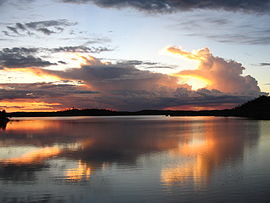Cloncurry, Queensland
|
Cloncurry Queensland |
|||||||||||||
|---|---|---|---|---|---|---|---|---|---|---|---|---|---|

Sunset at Chinaman Creek Dam, Cloncurry
|
|||||||||||||
| Coordinates | 20°42′0″S 140°30′0″E / 20.70000°S 140.50000°ECoordinates: 20°42′0″S 140°30′0″E / 20.70000°S 140.50000°E | ||||||||||||
| Population | 2,796 (2011 census) | ||||||||||||
| Postcode(s) | 4824 | ||||||||||||
| Elevation | 186 m (610 ft) | ||||||||||||
| Location |
|
||||||||||||
| LGA(s) | Shire of Cloncurry | ||||||||||||
| State electorate(s) | Mount Isa | ||||||||||||
| Federal Division(s) | Kennedy | ||||||||||||
|
|||||||||||||
|
|||||||||||||
Cloncurry is a town and locality in the Shire of Cloncurry, Queensland, Australia. It is the administrative centre of the shire. In the 2011 census, Cloncurry had a population of 2,796 people.
Cloncurry is known as the Friendly Heart of the Great North West and will celebrate its 150th anniversary in 2017.
Cloncurry is situated in the north-west of Queensland, 770 kilometres west of the city of Townsville via the Flinders Highway. The town lies adjacent to the Cloncurry River.
Cattle grazing is the significant industry in the region, and a large sale yards is located in the town.
The first Europeans to traverse the area were Burke and Wills on their epic, and ultimately fatal, transcontinental expedition. The Cloncurry River was named by Burke after Lady Elizabeth Cloncurry, his cousin, with the town eventually taking its name from the river.
Ernest Henry discovered copper in the area in 1867, and the town sprang up to service the Great Australia Mine to the south. Roger Sheaffe established the first pastoral run in the Cloncurry district - "Fort Constantine". Gold was discovered at Top Camp. The town was surveyed in 1876. Cloncurry was proclaimed a town in 1884.
The Cloncurry Advocate was a newspaper published in Cloncurry between 1889 and 1953.
Queensland's Northern Line railway reached Cloncurry in December 1907 and was officially opened the next year.
In 1914 a fire broke out in the town resulting in the destruction of the Post Office, the hotel, eleven shops, two store-rooms and a cottage. The telegraph office was saved by employees who kept the office damp and protected with wet blankets. One man died in the blaze which cost an estimated £15,000.
...
Wikipedia

